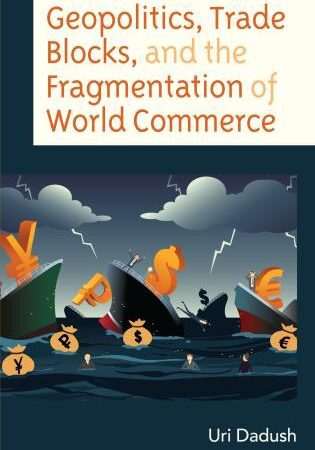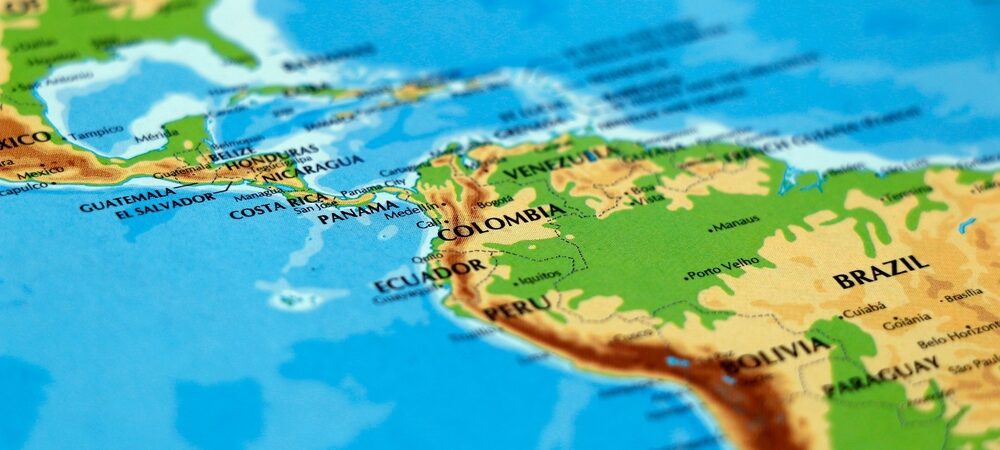Geopolitics, Trade Blocs, and the Fragmentation of World Commerce
The following is an excerpt from Uri Dadush’s newest book: “Geopolitics, Trade Blocs, and the Fragmentation of World Commerce”.
Introduction: A Global Emergency
The post-war trading system, which is at the foundation of our prosperity and orderly international relations, may be ending. Instead, ahead of us may lie an indefinite period of fragmentation of world trade and a more fractious and unstable world order. As trade rules embodied in the World Trade Organization (WTO)—which are imperfect and outdated but still constitute the bedrock on which the world trade edifice stands (Wolff, 2023)—become increasingly eroded, trade will be reconfigured inefficiently along regional and “friendship” lines. The global economy will slow, expectations of higher living standards will remain unmet, the poverty reduction of decades past may be reversed, and climate action will be impeded (Georgieva, 2023).
This book seeks to address the questions—uppermost in the minds of policymakers and analysts around the world—why fragmentation is happening, how it might evolve, and what can be done to prevent, or at least mitigate, the economic and political disruption that it will bring. I do not claim to provide a definitive answer, nor—frankly—would I expect anyone to do so. Indeed, uncertainty about what fragmentation will bring is the essence of the challenge it poses for policymakers and firms. I aim, however, to advance our understanding of fragmentation by considering both the politics and economic thinking that drive it, and the economic and security context within which it is occurring. I try to sketch possible outcomes of the fragmentation process and suggest policies that respond robustly to the uncertainty the erosion of trade rules is generating.
Along with a succession of crises—the Global Financial Crisis (GFC), China–U.S. tensions, the pandemic, the war in Ukraine—the prevailing narrative on globalization and trade changed. In many quarters trade is no longer viewed as a source of efficiency, growth, and peaceful relations but as a source of unfair competition, inequality, and a threat to national security. What did not change, however, is a compelling body of theoretical and empirical evidence dating back 250 years which shows that nations gain from international trade. If anything, the evidence continues to accumulate. Countries could not have fought the pandemic without trade in vaccines and medical equipment, and without foreign supply of everything when whole nations went into lockdown at various times. As the effects of climate change became more visible in prolonged droughts and other disasters, so did the need for trade in food, solar panels, and critical materials for batteries. As the world’s climate continues to deteriorate, nations will have to choose between agricultural trade and mass migration, and to choose between trade in environmental goods and use of fossil fuels.
Why did the narrative on globalization become so negative and why is the resurgence of protectionism threatening? One reason is as old as the annals of commerce yet remains fundamental. Nations gain from trade but, in sectors where they do not have comparative advantage, workers and capital invested lose, creating a coalition to resist trade. A sequence of crises which undermined confidence in globalization and discredited the prevailing policy paradigm bolstered the political resistance to free trade by those who lose from it. The “Washington Consensus” became the Washington dissensus.
The resistance to trade found new life in three developments. The first is the intensifying rivalry between China and the United States, the world’s superpowers, and largest economies. The second—and connected—development is a revolution and inward turn in the trade policy of the United States, the architect of the post-war system, which has its roots in its increasingly fractious social and political divisions, and to the rising inequality and macroeconomic instability of recent decades. The third development is the mounting concern that WTO rules are outdated and increasingly getting in the way of sovereign preferences in many areas. While traditional agendas such as differences in labor standards and in industrial policy (e.g., support to infant and declining industries) remain insufficiently addressed, even more pressing and divisive issues, namely climate change and national security took center stage.
Economic efficiency mandates that the right policy response to the mounting tensions is not to close trade but to address the problems at the core—to find a strategic accommodation with China, to mitigate the losses of some workers from trade with adequate social support, and to coordinate decarbonization policies. For all its shortcomings, there is enough flexibility in WTO trade rules to accommodate national preferences and where there is not, the WTO offers a means to achieve better coordination without unduly restricting trade. But however valid these arguments are, trade policy is a balancing act between conflicting interests and views, and the balance is rapidly and decisively shifting toward allowing countries more “policy space.”
It takes time for the world economy to change direction and this book shows that the fragmentation of world trade has barely started: it is not too late to prevent fragmentation. Protectionism and rule-breaking in many quarters have been offset by trade liberalization in others, especially under the growing number and increased depth of regional and mega-regional trade agreements. Global value chains continue to show remarkable resilience. Many companies that once called for protection have either become defunct or are adapting, reorienting toward world markets, importing cheaper inputs, drawing on foreign technology, investing overseas, and calling on equity and debt capital from abroad. Trade continues to grow, technology advances, enormous gaps in wages and productivity across the world persist, and the gains from globalization are far from spent.
Yet, the signs that the trading system is on the cusp—that an avalanche of protectionist measures has begun to roll and is building—are unmistakable. These signs now go well beyond the trade war between China and the United States and the sanctions on Russia and Iran. They include, for example, over thirty WTO trade disputes that remain in limbo after its Appellate Body became disabled, a vast increase in trade concerns expressed in WTO committees, large trade-distorting subsidies in the United States which has newly embarked on import-substituting industrial policy, and a widespread expectation that decarbonization measures will cause a new wave of trade disputes. Donald Trump is the Republican candidate in the 2024 Presidential election and has promised to escalate the trade war with China and impose an additional 10 percent MFN tariff on U.S. imports, which would amount to the United States tearing up the WTO and is bound to prompt retaliation by partners that account for most U.S. exports.
Avoiding fragmentation or, at least mitigating the damage it will cause, is possible. An essential condition is for China and the United States to reach an accommodation on trade. The tension in China–U.S. relations is no longer mainly about trade if it ever was, and nor is reduced trade the most worrying consequence of their rift. The rivalry between a rising China and the incumbent United States has preoccupied eminent American scholars such as Graham Allison (2017), John Ikenberry (2014), Henry Kissinger (2011, 2012), and Joseph Nye (2023). The perspectives they offer are diverse, but they build on the same assumption: the nuclear-armed giants have the means to destroy the other without realistic prospect of defense, and so they will coexist or not exist, and must be constantly wary of the risk of escalation. Others of the self-denominated realist school see a military conflict between the superpowers over supremacy in Asia as highly likely (Mearsheimer, 2006)….”
Dadush_Flyer(real)Read the Book Introduction Here
9/9/2024 | Uri Dadush
From Rhetoric to Reality: Nearshoring in the Americas
Executive summary
Over the past five years, global shifts have reshaped the world. China’s rise, US-China tensions, COVID-19, and Russia’s 2022 invasion of Ukraine exposed supply chain vulnerabilities, pushing resilience to the top of the agenda. Latin America and the Caribbean (LAC) can seize the opportunity to provide solutions for US companies through nearshoring. With the most US bilateral free trade agreements, geographic proximity, and abundant critical minerals and forms of renewable energy, LAC is perfectly positioned to support the “China+1” strategy while also meeting environmental, social, and governance (ESG) standards. Estimates suggest nearshoring could add an annual US$78 billion in additional exports of goods and services in Latin America and the Caribbean in the near and medium term. Similarly, nearshoring could allow the US government and US companies to diversify supply sources and build resilient supply chains, while boosting inclusive economic growth in the region.
How can nearshoring be transformed from rhetoric to action? How can the United States and regional governments work together to materialize nearshoring opportunities? How can the private sector be included in this endeavor? To answer these questions, the Atlantic Council created the Nearshoring Working Group, a multisectoral group of practitioners and experts from the United States and the region to help advance actionable policies to accelerate economic engagement across the hemisphere. Through numerous consultations with Nearshoring Working Group members and conversations with officials in the United States and across the region, this report identifies three overarching conditions that need to be met to materialize nearshoring, and suggests ten opportunities to achieve the three conditions.
Improving domestic “pull” factors
- Modernizing port and telecommunications infrastructure: Pursue modernization of port infrastructure to reduce transportation costs associated with nearshoring, and expand internet access.
- Improving “soft” infrastructure at border crossings: Leverage regulatory modernization and harmonization of customs processes to improve intraregional trade and coproduction.
- Offering reliable, clean energy sources: Create regulatory frameworks for renewable energies to reduce share of fossil fuel dependency, and update transmission lines to achieve reliable electricity.
- Providing legal certainty and fostering strong institutions: Offer predictable “rules of the game” for investors by strengthening independent regulatory agencies and pursuing digitalization of public services.
Unlocking US “push” factors
- Leveraging existing US trade policy toward the region: Work with partner countries to ensure provisions of current free trade agreements (FTAs) are best utilized in promoting nearshoring and supply chain resilience and sustainability.
- Tailoring development and investment policies to US strategic goals: Investment development policy must be tailored to US strategic goals, by lifting institutional constraints to International Development Finance Corporation (DFC) lending to LAC.
- Leveraging the existing toolbox across the US government: Include the breadth of US government programs and agencies as a tool of intragovernmental, bilateral engagements to catalyze nearshoring.
Enhancing public-private sector collaboration
- Strengthening workforce development: Closer collaboration between the public and private sectors is essential to close the skills gap between jobseekers and employers and improve the region’s human capital.
- Enhancing trade and investment promotion through multisectoral collaboration: Incorporate private-sector input in the decision-making process of investment promotion schemes such as investment promotion agencies (IPAs) and free trade zones (FTZs) to render both tools more effective.
- Supporting industries by following winners: Governments should provide incentives for winning industries to further grow, avoiding the draining of fiscal resources for industries that have yet to prove their yield.
September 17, 2024 | Adrienne Arsht Latin America Center’s Nearshoring Working Group | Atlantic Council
The CPTPP: a Benefit of Brexit
Britain is now a party to the Comprehensive and Progressive Agreement for Trans-Pacific Partnership, which includes many of the world’s richest and most dynamic economies. This would have been impossible without Brexit, and it is a very different kind of agreement to being a member state of the EU. This article explains why.
Last week Peru became the sixth country to ratify the UK’s accession to the Comprehensive and Progressive Agreement for Trans-Pacific Partnership (CPTPP), a trade agreement between 12 countries mostly surrounding the Pacific Ocean or the South China Sea, except for the UK. The agreement will come into effect on the 15th of December this year with the members who have ratified the agreement. So far that is Peru, Japan, Singapore, Chile, New Zealand and Vietnam. Hopefully, the other members (Australia, Brunei, Canada, Malaysia and Mexico) will finish their ratification process shortly.
The CPTPP includes some of the world’s most affluent and rapidly growing countries, with a total GDP of US$15.4 trillion in 2023.
No doubt the usual suspects will be complaining that the UK has given up its access to the EU for the CPTPP but that isn’t true. EU membership is very different from becoming a party to the CPTPP agreement. And the UK has retained its tariff-free and quota-free trade with the EU.
The CPTPP is focused on promoting market-driven economies and the elimination of tariffs and other trade barriers for manufactured goods, agricultural commodities, and services. It also establishes rules for investment and protection for investors, intellectual property, and communications, as well as transparency in government procurement. The CPTPP requires its parties to establish a committee to identify ways to assist SMEs in taking advantage of the commercial opportunities in the CPTPP and help them grow their exports. The CPTPP trade agreement has a chapter on the Environment, and it sensibly concentrates on achievable goals: protecting the oceans from ship pollution, overfishing, and illegal fishing; protection of wild flora and fauna, endangered species and their habitats; control of toxic chemicals, discharge of pollutants and environmental contaminants and protecting the ozone layer. These protections must be in each party’s legislation and be enforced by the members’ governments.
What the CPTPP is not is a group of countries moving towards a federal union. Unlike the EU, there is no CPTPP Commission, Parliament, Court, Flag or National Anthem and the UK doesn’t have to pay to be a member. The UK can determine its own VAT rates (and keep any money raised) and we are not forced to apply tariffs to goods imported from non-CPTPP countries – as we were when members of the EU. The CPTPP doesn’t even have one President, let alone five (like the EU). And most importantly the CPTPP does not require its members to adopt its regulations nor do UK courts have to defer to CPTPP laws above our own laws. And despite the social media rumours, the CPTPP won’t force the UK to give up its animal welfare regulations. (For the record, Chile does not allow cattle to be treated with hormone implants and it produces enough beef to fill the UK’s very small CPTPP beef quota.)
Quotas and tariff reductions
The usual suspects have also complained that the UK already has trade agreements with many countries in the CPTPP so there is no need to join. However, if these trade agreements were rolled over from the EU, then they will have had small quotas on many products that the UK needs to import but were in competition with other EU producers. When the UK left the EU we were generally given about 14% of the EU’s quotas with the CPTPP countries, this left us with small uneconomic tariff-free import allowances. And most of the EU’s trade agreements skipped over services – even though they are one of the UK’s largest export sectors.
The CPTPP goods liberalisation is generally better for UK consumers although the UK’s farmers have continued to get protection from CPTPP producers, even though they have no protection against EU producers. Inexplicably the UK has also limited rice and banana imports from other CPTPP parties.
But most UK import tariffs will be eliminated in full on CPTPP imports in December, at least from countries that have ratified the treaty. Although UK import tariffs on food that can be produced in the UK will be reduced more slowly. For example, imported beans will have their tariffs eliminated over 5 years, some types of apples will take 10 years, while dairy product tariffs will generally be lowered over 5 years although butter will take 11 years.
However, a lot of the UK’s protection from agricultural competition is unnecessary. The largest food exporters in the CPTPP are either in the southern hemisphere and so produce food in the opposite season to the UK or they are in the tropics and produce foods that cannot be grown in the UK climate. While the CPTPP’s two largest food exporters, Australia and New Zealand, have been limited to the quotas they received in their bilateral trade agreements with the UK so will not be eligible to use the CPTPP quotas.
This will be the UK’s first trade agreement with Malaysia, and it will allow the UK to import refined palm oil tariff-free directly from Malaysia rather than via EU refiners in the Netherlands, which import crude palm oil from Malaysia, refine it and then sell it to us (still!). While Malaysia will lower its 80% tariffs on imports of UK Whisky over 16 years (If you think this is unfair, please see the UK’s tariff reduction for Australia Beef or New Zealand Lamb).
Accumulation
Joining the CPTPP is particularly good news for UK manufacturers and exporters. The CPTPP’s process of accumulation allows imported materials, parts or semi-finished goods from other CPTPP countries to be counted as originating material if the finished product is exported to another CPTPP member.
Despite the delicious food and drink produced in CPTPP countries, they mostly export machinery and parts, electronics, oil and gas, minerals, chemicals, clothing and footwear. These products will probably become part of UK supply chains to benefit from the CPTPP’s process of accumulation. For example, if a UK fashion company uses wool or cotton produced in Australia, or cloth made in Malaysia, or manufactures their goods in a Vietnamese factory, these inputs count towards originating material under CPTPP rules so the finished products can be sold in other CPTPP countries at the CPTPP preferential tariff rate.
Similarly, if UK car manufacturers use Australian bauxite to make aluminium or car parts made in Malaysia, Japan or Mexico, then this will count as local content if the final vehicles are sold within the CPTPP. This is likely, as Brunei, Australia, Chile, Peru and New Zealand have no local vehicle producers and are dependent on imported cars, trucks, and mining vehicles.
Conclusion
It was very encouraging to see the new Trade Minister, The Rt Hon Douglas Alexander, announce the accession of the UK to the CPTPP. This coincided with rumours that the Prime Minister was trying to rejoin the EU by meeting with Chancellor Scholz in Germany and President Macron in France. If this was the aim of the meetings, it is misplaced. UK trade with the EU is doing fine but is hampered by the EU’s sluggish economies – not Brexit. While allowing the UK to fully benefit from increased trade with the dynamic economies of the CPTPP, will help the UK achieve the economic growth the Prime Minister is looking for.
9/4/2024 | Catherine McBride | Briefings for Britain
Breaking Barriers: Enhancing Women’s Participation in Trade Across the Indo-Pacific
A gender-inclusive trade agenda will help create better jobs and unlock greater economic potential.
The persistent gap between male and female labour market participation is a trend common to all regions of the world. Across the Indo-Pacific region, research shows that women are not benefiting from job growth in new sectors as much as men.
A missing link in the conversation on improving women’s participation in the Indo-Pacific economies is the role of trade. The region, which has an outsized influence on geopolitics and accounts for nearly half of global trade, can be critical for accelerating women’s economic participation and promoting inclusive growth through trade.
The inextricable link between gender equality and trade has become well established in recent years. Trade directly improves women’s lives, by creating better jobs, increasing women’s wages and welfare, and creating opportunities for women to move into higher-skill work and entrepreneurship. Firms that are part of global value chains demonstrably employ more women in developing countries. Women make up 33% of the workforce of firms that engage in international trade, compared with 24% in firms that do not.
The impact of trade on gender equality is wide-ranging – trade enhances women’s access to education, healthcare and technology.
Despite its potential for improving outcomes for women, gender has received little attention in international trade. Globally, only 15% of firms engaged in international trade are led by women. In OECD countries, 27% of women’s jobs are dependent on exports, compared to 37% for men. International trade is not favourable for women who face a wide range of barriers that include social norms and gender biases, mobility constraints, policy and legal hurdles, and restricted access to finance, technology and information.
However, recent trends in international trade present an opportunity for increasing women’s participation. This includes the overall increase in regional and cross-border trade and the dominance of global value chains, the rise of services in trade, and the expansion of green trade and digital trade.
Together these shifts represent the need for a workforce with upgraded skills, creating space for more women to enter the trade sector.
Governments and multilateral and international organisations have more recently started acknowledging that trade is not gender-neutral and seeking ways to address the global gender gaps in trade. This year’s G20 presidency under Brazil has identified boosting women’s participation in international trade as an organisation priority for the first time.
Gender provisions are also increasingly a part of trade policy and trade agreements. According to the World Trade Organisation, as of September 2022, 101 of the Preferential Trade Agreements out of 353 included an explicit reference to gender issues. Very few of these gender-related commitments, however, are enforceable.
Interestingly, the WTO, which has been advocating for gender-inclusive trade, has its own gender gaps to fill. Only 36% of ambassadors and 30% of ministers in charge of decision-making at WTO are women.
Australia has been seeking to elevate the conversation on gender segregation in trade. It endorsed the WTO’s Buenos Aires Declaration on Trade and Women’s Economic Empowerment in 2017, and in February 2024 became a member of the Global Trade and Gender Agreement. A new International Gender Equality Strategy being developed by the Department of Foreign Affairs and Trade will reflect the commitment to reduce gender gaps in trade.
The Indo-Pacific, which includes some of the world’s largest economies as well as the fastest-growing economies, and “mega-regional” free trade agreements, has the potential to propel inclusive economic growth and improve the economic security of women.
There are several ways for the region to work towards this goal. Established regional forums for economic cooperation such as the Association of Southeast Asian Nations and the Asia-Pacific Economic Cooperation forum can play a critical role in engaging governments, the private sector and businesses to promote inclusive trade in the region.
Gender mainstreaming is integrated into newer initiatives, including the Indo-Pacific Economic Framework for Prosperity (IPEF), a regional initiative of 14 governments to build economic integration in the Indo-Pacific, with Australia, the United States, Japan and India as members. IPEF lists trade as one of its four core pillars, and explicitly underlines the need for inclusivity in trade, removing barriers to economic empowerment and encouraging greater participation by women.
Gender equality must be a critical part of building supply chain resilience in the region. Women are under-represented in global supply chains, work in vulnerable and precarious conditions, and are concentrated in low-skilled employment.
The Supply Chain Resilience Initiative (SCRI) between Australia, India and Japan could be another initiative to promote increased employment and entrepreneurship opportunities for women. IPEF, SCRI and the Quad group each list enhancing the workforce of supply chains in critical sectors as a priority, and could have targeted training and skilling programs with gender quotas.
Trade facilitation directly benefits women and enhances their participation in trade-related services. Countries such as India and Australia, leaders in trade facilitation, can work with countries in South Asia and the Pacific to promote gender-sensitive trade facilitation processes in their neighbourhoods.
The Indo-Pacific region, most often cited as a geopolitical flashpoint for trade, can be at the forefront of advancing a gender-inclusive trade agenda.






